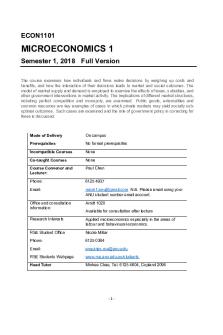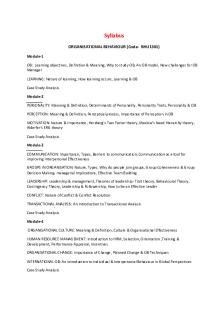2810NRS-Family - Full course notes PDF

| Title | 2810NRS-Family - Full course notes |
|---|---|
| Course | Child and Family Health |
| Institution | Griffith University |
| Pages | 5 |
| File Size | 157.2 KB |
| File Type | |
| Total Downloads | 101 |
| Total Views | 149 |
Summary
Full course notes...
Description
2810NRS End of trimester exam breakdown Module 1 Introduction to family nursing. Definitions of family: a group of persons united by ties of marriage, blood, or adoption, constituting a single household. Family types: - Traditional nuclear; a husband and wife with their biological children. - Binuclear; post-divorce family (both parents remarried, and child is member of two families now). - Extended; nuclear family shares house with another relative e.g. grandparents. - Blended; two parents with their respective children joining together. - Single parent; mother or father widowed, separated or divorced. - Foster; temporary family accommodation. - Adoptive; no consanguine ties with but provides family focussed care (permanent). - Grandparent reared; grandparents take on parental role for grandkids. Families in Australia: - Couples with children (37.8%) - Couples with dependent children (36.7%) - One-parent families with dependent children (10.6%) - Couples with non-dependent children only (7.9%) - One-parent families with non-dependent children only (5.3%) - Grandparent reared families (1%) The three theoretical approaches related to families: - Family systems theory; individuals cannot be understood in isolation from one another, viewed as a broader emotional system/ unit. Change to one individual impacts everyone in family. - Family development theory; how families handle change over time, systematic and patterned changes as the family moves through their life course. - Structural/ functional family theory; the structure of a family and how it enables them to function in society. (roles, values, communication, and power structure). Family function Family Health
Characteristics of a healthy family: good communication, affirm and support, respect, trust, humour, shared responsibility, sense of right and wrong, respect privacy.
Family issues and challenges: Protective and risk factors for families: childhood illness, maternal illness, poor attachment, smoke filled environments, lower parental education, large number of kids, stress, single parents, unstable family, death of family member, inadequate housing, isolation, poor health care access.
Family violence: intimate partner violence (domestic), child abuse, sibling abuse, elder abuse. Manifests as physical, verbal, sexual, psychological abuse ; neglect ; financial abuse ; stalking ; harm to property.
1
Nursing Process: assess, plan, implement, evaluate.
Module 2 Prenatal Health • Contraception: prevents pregnancy (birth control). Examples: - Lactational amenorrhea method (breastfeeding) - Fertility awareness based methods (knowing when most fertile) - Barrier methods (condoms) - Long acting reversible contraceptives (Intrauterine Device, Hormonal IUD, Contraceptive Implant, Contraceptive Injection) - Hormonal methods (Oral Contraceptive Pill, Hormonal Vaginal Ring, Progestogen-only Pill, Emergency contraceptive oil) - Permanent methods (sterilisation or vasectomy) - Other (pull out method) Pregnancy phases: -
First trimester (0-12 weeks): tiredness, upset stomach, nausea and vomiting, mood swings, tender breasts, heartburn, weight gain, headaches, cravings.
-
Second trimester (12-27 weeks): uterus expands, larger abdomen showing, dizziness or light headedness (lower BP), baby moves, body aches, increased appetite, stretch marks, skin changes, itching, swelling of ankles/ hands. Third trimester (28-40 weeks): increased baby movement, tightening of uterus (Braxton Hicks contractions), frequent urination, heartburn, swollen ankles/ fingers/ face, haemorrhoids, tender breasts/ leaky breasts, difficulty sleeping.
-
Antenatal care: -
Promoting healthy maternal behaviours (nutrition, not smoking or drinking alcohol), monitoring the foetal health, educating mother about normal or abnormal signs and symptoms, providing education about birthing/ postnatal phase/ and transition to parenthood.
Postnatal Health Infant feeding: - Challenges: inadequate milk production, ineffective latching, nipple injury (pain), engorgement (full breasts), plugged milk ducts, nipple/ breast infections (mastitis).
Module 3 Infant/child health in the non-acute setting/ Nursing care of infants/children non-acute • • • • • • • •
Physical, cognitive and psychosocial development Principles of growth and development Factors which may influence physical growth patterns Developmental milestones – cognitive, physical and psychosocial Childhood obesity Child abuse Developmental theorists Stages of play
2
Infant/child assessment non-acute Newborn assessment • Growth and development: - Weight doubles by six months, triples by twelve months. - Length increases by 50% by 12 months, and 75% by two years. Child assessment • Growth and development: o Airway, breathing, circulation, disabilities kids are different to adults o Airway, breathing, circulation, disabilities assessment and normal findings • Communication with children • Immunisations • Nutrition
Infant/child health acute • •
Reasons an infant or child may visit an acute setting Interacting with infants/children in your care Infant/child issues and challenges acute
• • •
Paediatric emergencies Hospitalisation Allergy
Infant/child assessment in the acute setting • • • • • • • •
Principles for assessing infants/children Recognition of the deteriorating child Red flag, pre terminal indicators when assessing Paediatric anatomy and the implications Primary survey and exposure the secondary survey Pain management and assessment Pain intervention Module 4
Adolescent health Developmental changes of adolescence: - Growth spurt, sexual maturation. - Personal identity, self-esteem. - Increasing autonomy and independence from family. - Educational transition – primary to secondary school. - Peer relationships. - Increasing self-responsibility for health and wellbeing. Physical, brain, cognitive and psychosocial development: - Physical: reproductive maturity reached, significant body and hormonal changes. Growth spurt occurs, puberty reached (sexual maturation), menarche (first period), spermarche (onset of sperm release). - Cognitive: they understand more abstract concepts, recognise uncertainty and contradictions, ability to sympathise and reason develops. - Psychosocial: establish friendships with similar gender or maturity levels, spend more time with peers rather then family, discuss problems/ fears/ feelings/ doubts with best friends rather than parents and family, engage with variety of friends, romantic relationships develop. Language becomes more complex, mood swings, prone to alcohol and drug abuse,
3
independence, identity crisis, sexual experiences, sense of identity, health care needs/ personal habits/ time/ money awareness. Protective and risk factors: -
Risk: drug and alcohol use, smoking, dangerous driving, unprotected sex.
-
Protective: positive self-identity, effective coping mechanisms, family connectedness, health social and peer connections, positive role models, supporting and safe school and community environments, accessible health care.
Nursing care of Adolescents Principles for adolescent assessment - Recognise young person’s growing autonomy along with diminished role of parent in promoting health and well-being. - Not all young people are at the same stage physically, cognitively, and psychosocially. - Psychosocial issues and risk taking behaviour cause morbidity and mortality a lot more. - Physical complaints connected to psychosocial issues. - Important to gain trust and empathy – vigilant of professional boundaries as well. - Respectful and non-judgemental approach. Physical assessment: - Before Examination: Privacy is important, tailored to young persons age and developmental stage, who is required to be present during the examination, reason for examination must be communicated to the youth, reassured to voice concerns, nurse leave room when youth is changing, request removal of minimum amount of clothing, provide sheet or gown. - During Examination: nurse consider normal parameters for persons age and developmental stage, provide immediate feedback on findings to the adolescent, open to questions and comments. Assessment – HEADDSSS: H - Home or housing – who lives with them, do they argue, do they feel safe there. E – Education/ employment – what grade, what courses do well in, suspended?, do you have a job? A – Activities – fun, trouble with the law?, active in sports? D – Drugs/ dieting – friends that drink or smoke or use drugs, ever tasted alcohol, what drugs used. D – Dieting – satisfied with weight? S – Sexual activity – sexual history, unwillingly had sex, use of contraception. S – Suicide and depression – feel depressed or about hurting themselves? S – Safety - victim of violence?, gun in house?, wear your seatbelt? Rights and consent: - Nurses must be aware of the rights of an adolescent identified in the Convention on the Rights of the Child (CRC). Privacy and confidentiality: - Nurses treat personal information obtaining in a professional capacity private and confidential. - Have ethical and legal obligations to protect the privacy of people receiving care. - Inform a person that in order to provide competent care it may be necessary to disclose their information to members of a health care team. - Seek consent from the person before disclosing information. - Unless person may self-harm or harm someone else; are at risk of harm from someone else; or there are concerns about their safety, welfare or wellbeing. Therapeutic communication:
4
-
Engaging the young person and their family in decision making.
-
Using adolescent friendly language.
-
Avoiding the use of medical jargon.
-
Valuing and promoting family strengths.
-
Phases: introductory phase, building trust phase, comfort and reassurance phase, decision making phase.
5...
Similar Free PDFs

Full Notes - Course hero
- 60 Pages

Statistics 108 - Full Course Notes
- 14 Pages

ECON 130 Full Course Notes
- 87 Pages

Equity and Trusts Full Course Notes
- 30 Pages

Course Outline - Full Version
- 10 Pages

FULL Notes
- 229 Pages

Full notes
- 102 Pages
Popular Institutions
- Tinajero National High School - Annex
- Politeknik Caltex Riau
- Yokohama City University
- SGT University
- University of Al-Qadisiyah
- Divine Word College of Vigan
- Techniek College Rotterdam
- Universidade de Santiago
- Universiti Teknologi MARA Cawangan Johor Kampus Pasir Gudang
- Poltekkes Kemenkes Yogyakarta
- Baguio City National High School
- Colegio san marcos
- preparatoria uno
- Centro de Bachillerato Tecnológico Industrial y de Servicios No. 107
- Dalian Maritime University
- Quang Trung Secondary School
- Colegio Tecnológico en Informática
- Corporación Regional de Educación Superior
- Grupo CEDVA
- Dar Al Uloom University
- Centro de Estudios Preuniversitarios de la Universidad Nacional de Ingeniería
- 上智大学
- Aakash International School, Nuna Majara
- San Felipe Neri Catholic School
- Kang Chiao International School - New Taipei City
- Misamis Occidental National High School
- Institución Educativa Escuela Normal Juan Ladrilleros
- Kolehiyo ng Pantukan
- Batanes State College
- Instituto Continental
- Sekolah Menengah Kejuruan Kesehatan Kaltara (Tarakan)
- Colegio de La Inmaculada Concepcion - Cebu








